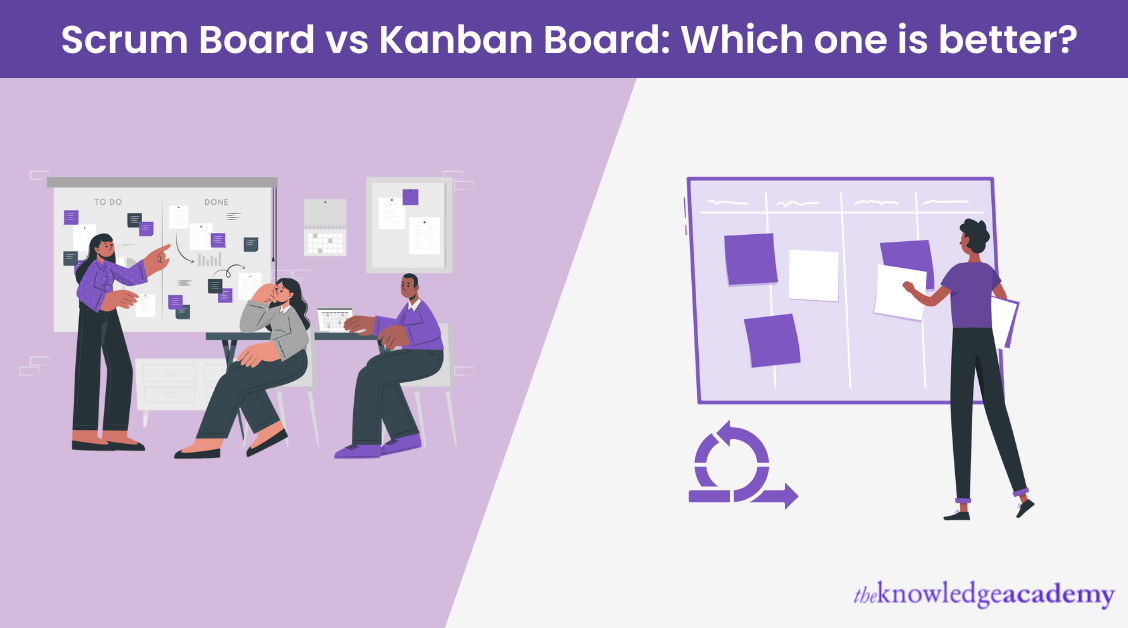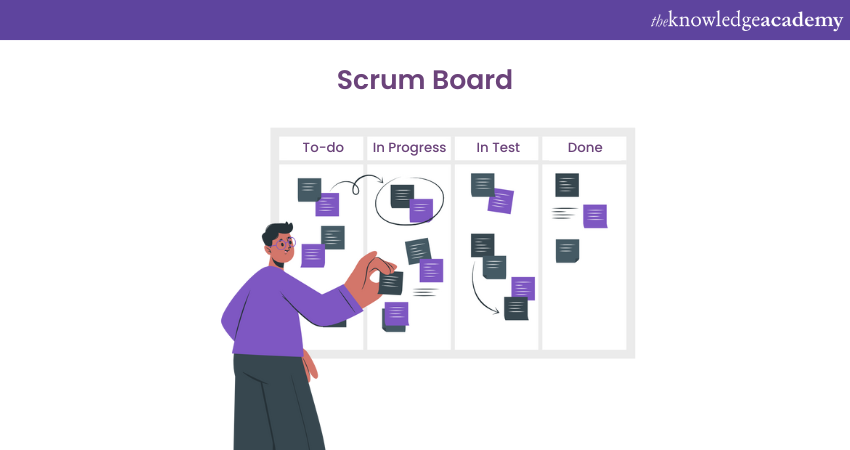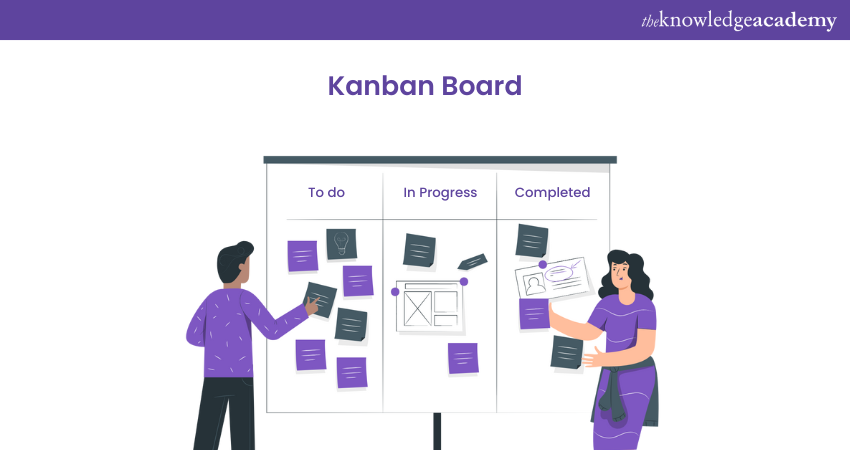We may not have the course you’re looking for. If you enquire or give us a call on 01344203999 and speak to our training experts, we may still be able to help with your training requirements.
Training Outcomes Within Your Budget!
We ensure quality, budget-alignment, and timely delivery by our expert instructors.

When it comes to project planning, there is always a tussle between choosing from the two best tools under Project Management methodologies: Scrum Board vs Kanban Board. Both methods depend on visual boards to monitor tasks and progress, and Scrum Board is more structured while Kanban is more fluid. Apart from this, there are a lot of differences that you should consider before choosing either of these for your organisation.
Both tools work on agile principles, be it a Scrum Board or a Kanban board. According to KPMG Global Agile Survey, 91% of IT businesses use agile principles and approaches. As both these tools follow Agile methodology, it must be a brainer why Scrum and Kanban are this popular. In this blog, we will examine the difference between Scrum Board vs Kanban Board. So, let’s dive deep in and discover the pros and cons of each of these!
Table of Contents
1) What is Scrum Board?
2) What is Kanban Board?
3) What are Scrum and Kanban Board tools?
4) Differences between Scrum and Kanban Board
a) Goal
b) Duration
c) Authority
d) Sprint delays
e) Board content
f) Documents
g) Limitations of working process
5) Scrum Board vs Kanban Board: Which one to choose?
6) Conclusion
What is a Scrum Board?

A Scrum board is like a visual tool that helps keep the team organised and track their progress using the Scrum framework. It usually consists of a whiteboard, or a virtual board divided into horizontal and vertical columns. Each column represents different stages of the project, such as To-do, In Progress, In Test, and Done. This makes it easy for team members to see what tasks are in progress, what needs to be done, and what is already completed.
The Scrum Board tracks the work progress in sprints, which cannot be changed once the task is added to a column. The team members must finish the task added to the board before completing a sprint. It allows for better collaboration, transparency, and efficiency in the project.
What is Scrum?
Scrum, a dynamic Project Management approach, emphasises collaborative efforts to achieve project completion within designated timelines. The methodology involves breaking down projects into manageable sprints, each requiring completion within a specified timeframe. This iterative process, known as Scrum of scrum, typically spans 1-4 weeks per sprint. Post-sprint completion, a thorough team review is conducted to assess achievements and plan subsequent sprints. The interconnected nature of this approach ensures that the initiation of a new sprint only occurs after the completion and review of the preceding one, contributing to the overall success of projects. Scrum fosters adaptability and collaboration within a team, allowing adjustments based on changing priorities. A Scrum team consists of a Product Owner, Scrum Master, and a Development Team that includes Software Engineers and various other development personnel.
Benefits of using Scrum Board
A Scrum Board is a physical or virtual tool that helps the project team manage their work effectively. It allows team members to see and track the work progress, and this helps them to communicate about the remaining task and accomplish them within the schedule.
Using a Scrum Board promotes team collaboration, leading to a more efficient and productive workflow. Additionally, the team works as a whole and supports each other in removing any obstacles that may prevent the team from achieving its goals.
Gain detailed knowledge of Scrum Master techniques with Scrum Master Certification!
What is Kanban Board?

A Kanban Board is a simple board to visualise and keep track of work that is pending or in progress. It usually consists of a physical or digital board representing different stages of work as “To do”, “In Progress”, and “Completed”. In general, sticky notes or cards are used to represent individual tasks, and it moves inside the board accordingly.
The open board system in Kanban allows everyone to see the status of the work progress and prioritise the work accordingly. There should be enough tasks to keep each person in the team engaged while it does not bottleneck the system.
What is Kanban?
Kanban is a Japanese term meaning ‘signboard’. It is a visual Project Management tool that helps keep the team organised and improves work efficiency. The Kanban method was developed in the Toyota factory to keep track of the production progress but was later adapted for use in software development, marketing, and healthcare. The concept behind Kanban is to work on projects individually using a board or cards to visualise the flow of tasks.
Kanban helps reduce time waste, improves team communication, and leads to higher customer satisfaction. At times Kanban is used with Scrum in a hybrid format known as Scrumban.
Understand the key features of Agile and Scrum along with its framework, manifesto, roles, and responsibility by having an Agile And Scrum Awareness course today!
Benefits of using the Kanban Board
Kanban Board is a great tool for managing tasks and projects more efficiently. The task in the Kanban Board flows from “To do” to “In Progress”, and finally “Completed”. It helps prioritise the task, accordingly, focus on what is important, and remove the least important work. This method is simple and easy to understand. Hence, it becomes a great choice to implement for individuals as well as teams.
Kanban helps increase productivity, reduce stress, and improve team collaboration, leading to better outcomes and increased satisfaction. Kanban Board is completely customisable as it allows adding and removing tasks between ongoing projects.
What are Scrum and Kanban Board tools?
Given below are some Scrum and Kanban Board tools:

Differences between Scrum and Kanban Board
Although Scrum and Kanban Board have many similarities, it has some major differences that make both tools apart. Here are some of the differences given below:
|
Key Factors |
Scrum Board |
Kanban Board |
|
Goal |
Scrum Board is used in the Scrum methodology for Agile Project Management. |
Kanban Board is used in Kanban methodology for Agile Project Management. |
|
Duration |
Scrum Board is generally used in software development and the IT field. |
Kanban Board is generally used in the lean methodology. |
|
Authority |
In Scrum Board, the focus is on specific sprints. |
In Kanban Board, the focus is on the continuous flow of work. |
|
Sprint Delays |
Scrum Board typically has columns such as To-do, In Progress, In Test, and Done. |
Kanban Board typically has columns such as “To do”, “In Progress”, and “Completed”. |
|
Board Content |
Scrum Board highlights teamwork and collaboration. |
Kanban Board highlights flexibility and adaptability. |
|
Changes |
Changes cannot be made during a sprint. |
Changes can be made at any time during a project. |
|
Roles |
The Product Owner, Scrum Master, and Development Team are responsible for maintaining the Scrum Board. |
There are no specified roles responsible for maintaining Kanban Board. |
|
Documents |
Documentation process relies on the user stories, where the tasks are outlined in the document. |
There are no specific documents, but instead a collective set of them, allowing for greater flexibility. |
|
Limitations |
Has a fixed deadline with rigid sprint timelines for an allotted task. |
Predefined sprints do not exist, making the deadlines flexible in nature. |
Goal
Scrum Board allows you to trace and manage a discrete part of a single sprint, which was made by a single Scrum team. It prioritises the single sprint within a team, thus bringing a clear delineation. On the contrary, the Kanban board allows you to trace the working of a team member in a project. Additionally, it changes the status of a task from “to-do” to “complete”, showing its completion.
Duration
Scrum’s duration tends to follow a two-week cycle, bringing a structure to the timeline. It makes the overall task have greater predictability, allowing people working to plan future events accordingly. In comparison, Kanban works continuously without a fixed timeline. These timeless sprints have the benefits of letting the team members working at their own pace without rushing the work and sabotaging the overall quality.
Authority
Authority tends to be extremely decentralised in Scrum, as self-organising teams are encouraged to make their independent decisions. As a result, each team member has a sense of freedom and responsibility regarding their respective work, thanks to the autonomy. In comparison, Kanban tends to have a flatter authority structure, with some hierarchical layers.
The difference between both does not necessarily make one better than the other, but depending on the working ethics of an organisation, the preferred approach may vary. Factors such as how much trust a higher- up has on the working ethics of an individual team may play a huge factor on which approach is preferred.
Sprint delays
Scrum normally mitigates the possibility of a delayed sprint by following fixed sprint durations. Fixing a certain duration to the sprints, referred to as timeboxing, allows the working teams and its their members to stay focused on their work. The team members end up prioritising their respective tasks due to the pressure of a fixed timeline, thus feeling compelled to finish it on time.
While sprint delays are normally avoided in Scrum, thanks to its timeboxing, it doesn’t factor in external variables. As a result, an unexpected change or issue can highly affect the workflow due to the rigid timeline. In comparison, Kanban doesn’t have any predefined timeline, allowing working teams to adapt to external issues if they arise in future.
Board content
Board content has a huge impact on how teams collaborate with each other, as it determines the clarity ofn the objective of the project. Scrum Boards tend to be extremely comprehensive at integrating the use of stories and backlog by breaking down the complex project intoas actionable tasks. Additionally, it prioritises the list of important tasks in a list of work items, which aligns with the overall work in the current sprint.
In comparison, Kanban Boards are created with a broader approach, as they cater to technical and non-technical teams alike. As a result, it doesn’t mandate the usage of sprint backlogs or user stories making it much more flexible than Scrum. It gives Kanban the benefit of being able to work with a larger variety of projects.
Documents
Documentation’s effectiveness plays an important part in managing the accessibility of vital information in project management. In the case of Scrum, the documentation process depends on user stories providing detailed descriptions of requirements, and Sprint planning, the document outlining chosen tasks.
In comparison, Kanban doesn’t prescribe any form of specific documents like Scrum does;, however, it accommodates different documentation based on the requirements of the project. As a result, while Scrum focuses on bringing structure to the documentation procedure, Kanban offers the flexibility of choosing from a set of multiple documents.
Limitations of working process
Every project management approach has its respective limitations, this is applicable to Scrum and Kanban as well. Scrum's fixed sprint timelines can cause rushed work, while Kanban's lack of predefined sprints can be a challenge for task boundaries. Addressing these limitations and striking the right balance between structure and flexibility is the key to successful project management.
Scrum Board vs Kanban Board: Which one to choose?
Scrum and Kanban Board are two popular Agile Project Management tools that are used to visualize the work progress to make it easier to track. Choosing between the two solely relies on the specific needs of your team and the types of projects on which your organization works. When exploring Agile methodologies, it's essential to consider Scrum tools and Kanban Board options to enhance your project management practices.
Scrum Board might be a better choice if you have a fixed timeline and a clear set of deliverables. To keep the track of tasks you can use Scrum template. On the other hand, if you are working on a project with no fixed deadlines and require a continuous flow, Kanban Board might be a better choice. It is important to evaluate the need of your organisation and the project and, ultimately, the team’s preference before making a final decision.
Conclusion
Scrum Board vs Kanban Board, there is always a doubt while choosing which one will suit my organisation. It entirely depends upon your team and organisation. Each framework helps increase productivity by providing unique benefits such as creativity and team collaboration. One of the major factors that help in deciding the tools you need is the team size and complexity of the project. You can find the board that works best for your team by considering everything and continually evaluating and adjusting as needed.
Gain an understanding of the benefits of using Agile alongside key concepts, history, and features of Scrum by taking the Managing Agile Projects With Scrum course!
Frequently Asked Questions
Upcoming Business Improvement Resources Batches & Dates
Date
 Scrum Master Certification
Scrum Master Certification
Thu 1st Aug 2024
Thu 8th Aug 2024
Thu 15th Aug 2024
Thu 29th Aug 2024
Thu 5th Sep 2024
Thu 19th Sep 2024
Thu 26th Sep 2024
Thu 3rd Oct 2024
Thu 10th Oct 2024
Thu 17th Oct 2024
Thu 24th Oct 2024
Thu 31st Oct 2024
Thu 7th Nov 2024
Thu 21st Nov 2024
Thu 5th Dec 2024
Thu 19th Dec 2024
Thu 2nd Jan 2025
Thu 9th Jan 2025
Thu 16th Jan 2025
Thu 23rd Jan 2025
Thu 30th Jan 2025
Thu 6th Feb 2025
Thu 13th Feb 2025
Thu 20th Feb 2025
Thu 27th Feb 2025
Thu 6th Mar 2025
Thu 13th Mar 2025
Thu 20th Mar 2025
Thu 27th Mar 2025
Thu 3rd Apr 2025
Thu 1st May 2025
Thu 22nd May 2025
Thu 5th Jun 2025
Thu 19th Jun 2025
Thu 3rd Jul 2025
Thu 17th Jul 2025
Thu 31st Jul 2025
Thu 14th Aug 2025
Thu 11th Sep 2025
Thu 25th Sep 2025
Thu 2nd Oct 2025
Thu 9th Oct 2025
Thu 16th Oct 2025
Thu 23rd Oct 2025
Thu 30th Oct 2025
Thu 6th Nov 2025
Thu 13th Nov 2025
Thu 20th Nov 2025
Thu 27th Nov 2025
Thu 4th Dec 2025
Thu 11th Dec 2025
Thu 18th Dec 2025







 Top Rated Course
Top Rated Course



 If you wish to make any changes to your course, please
If you wish to make any changes to your course, please


